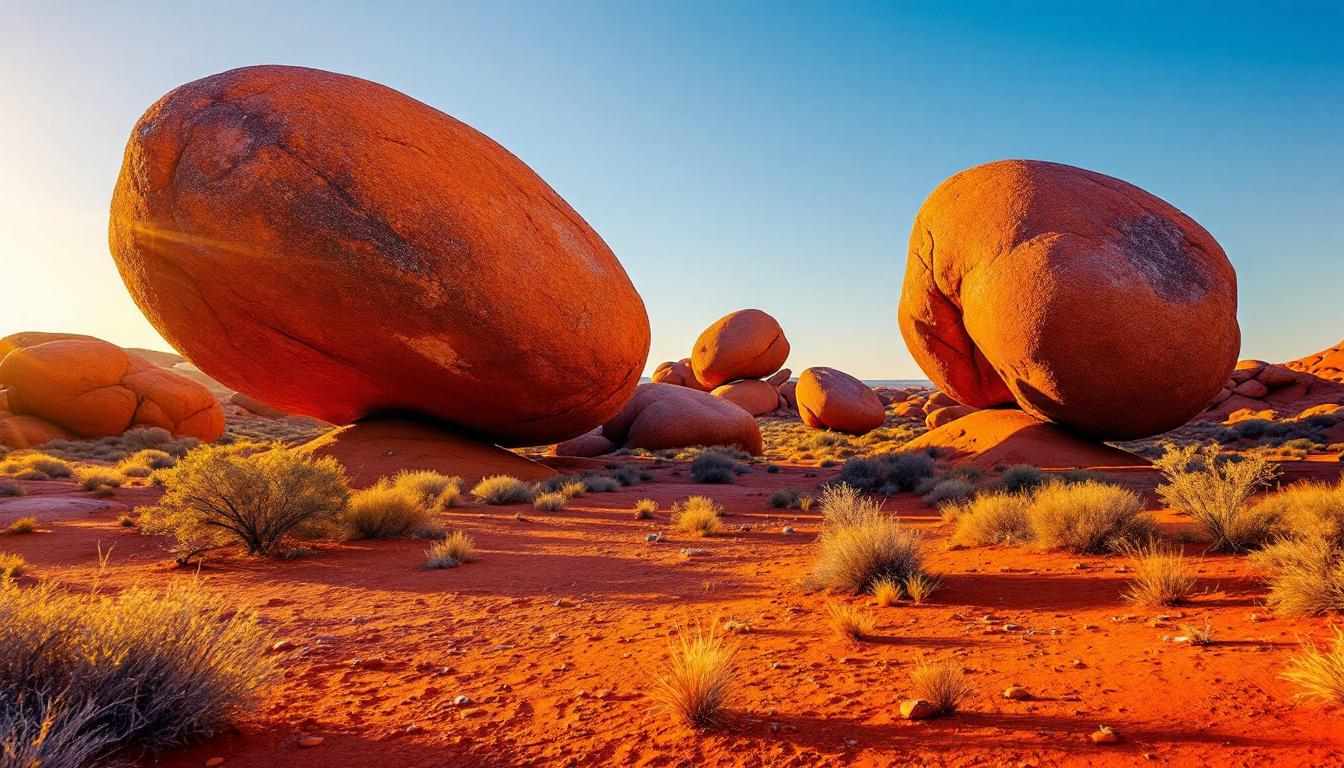When most travelers think of Australia’s sacred sites, they imagine the crowds and $38 entry fee at Uluru. But 400 kilometers north of Alice Springs sits a geological wonder that costs absolutely nothing and offers something Uluru can’t: genuine solitude with the world’s most spectacular balancing rock formations.
Karlu Karlu, known to non-Indigenous Australians as Devils Marbles, spans just 1,050 hectares yet contains over 500 massive granite boulders that have balanced precariously for 1.7 billion years. The Warumungu people call this tiny sacred site home, and their joint management with Parks Australia since 2008 has kept it refreshingly uncommercial.
Unlike Uluru’s bus tours and resort hotels, this sacred landscape welcomes just 106,000 visitors annually compared to Uluru’s estimated 700,000. The difference isn’t just in numbers—it’s in the profound connection you’ll experience when you’re not fighting crowds for that perfect sunrise photo.
The accessibility that surprises every traveler
Easier to reach than you’d expect
Despite sitting in Australia’s Red Centre, Karlu Karlu defies every expectation about remote outback access. The Stuart Highway runs directly past the entrance, making it accessible to any rental car without 4WD requirements. Most travelers discover it’s actually closer to major centers than many popular attractions—just 105 kilometers south of Tennant Creek.
Zero entry barriers, maximum impact
While Uluru charges $38 for a 24-hour park pass, Karlu Karlu welcomes visitors completely free of charge. You’ll find well-maintained walking trails, interpretive signage, and camping facilities without a single turnstile or ticket booth. The Warumungu Traditional Owners and Parks Australia have prioritized cultural connection over commercial profit.
Sacred stories that Uluru’s crowds never hear
Living Dreamtime in perfect solitude
The Warumungu creation stories tell of ancestral beings who scattered these massive boulders across the desert landscape during the Dreamtime. Unlike Uluru’s heavily managed cultural presentations, here you’ll experience these ancient narratives through subtle interpretive displays that respect traditional protocols while sharing sacred knowledge.
Authentic cultural encounters without commercialization
Joint management means Traditional Owners maintain daily presence at Karlu Karlu, often sharing cultural insights with respectful visitors. You might encounter Warumungu rangers conducting traditional land management practices or explaining the cultural protocols that have protected this site for over 50,000 years—experiences impossible amid Uluru’s commercial tourism machine.
Natural phenomena that outshine the famous neighbor
Geological marvels beyond monoliths
These granite giants showcase something Uluru cannot: the incredible physics of natural balance. Boulders weighing hundreds of tons rest on tiny contact points, defying gravity through 1.7 billion years of erosion. The spherical shapes result from unique exfoliation weathering that created Australia’s most photogenic rock formations.
Photography opportunities without the restrictions
While Uluru prohibits photography from many angles due to cultural sensitivity, Karlu Karlu welcomes photographers to capture the sunrise and sunset illuminations that turn the granite formations into glowing sculptures. The unrestricted access means you’ll frame shots impossible at more regulated sites.
Practical advantages that matter most
Camping among the giants
The on-site campground places you literally among the sacred boulders for $15 per night, with fire pits, clean toilets, and picnic tables. Imagine waking to sunrise light hitting these ancient formations from your tent door—an experience that costs hundreds at Uluru’s resort accommodations.
Perfect winter weather without the summer chaos
July brings ideal 20-25°C daytime temperatures and brilliant stargazing conditions without Uluru’s summer heat or wet season access issues. The reduced daylight hours intensify the color displays across granite surfaces, creating photographer’s paradise conditions with minimal crowds.
Karlu Karlu proves that Australia’s most profound sacred site experiences don’t require expensive park passes or fighting tourist hordes. This tiny conservation reserve offers something increasingly rare: authentic connection with ancient landscapes and living culture.
The Warumungu people have protected this sacred site for millennia, and their continued guardianship ensures every visitor experiences the spiritual power that makes Karlu Karlu more meaningful than any crowded alternative. Discover more authentic Aboriginal cultural experiences that showcase Australia’s true heritage beyond the tourist trails.
Planning your visit to Karlu Karlu
How do I get to Karlu Karlu from major cities?
Drive 393 kilometers north from Alice Springs via Stuart Highway (4.5 hours), or 105 kilometers south from Tennant Creek (1.5 hours). The site sits directly on the highway with clear signposting—no 4WD required.
What camping facilities are available?
Book campsites online for $15/night including fire pits, toilets, and picnic tables. WiFi hotspot available in day-use areas. Wauchope settlement 9 kilometers south provides basic supplies.
Are there guided tours like at Uluru?
Karlu Karlu focuses on self-guided exploration with interpretive trails and cultural information boards. Warumungu rangers occasionally share cultural insights with respectful visitors, but no formal tour programs operate.
What’s the best time to photograph the formations?
Sunrise and sunset create spectacular red-orange glows across the granite. Winter months (May-August) offer comfortable temperatures and brilliant clear skies perfect for photography.
Can I climb the rocks like at other sites?
Climbing is restricted to protect both cultural values and visitor safety, except at designated areas like Nyanjiki Lookout Walk. Respect cultural protocols by staying on marked trails.
